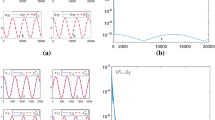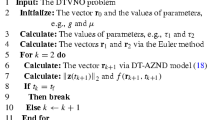Abstract
A novel finite-time convergent zeroing neural network (ZNN) based on varying gain parameter for solving time-varying (TV) problems is presented. The model is based on the improvement and generalization of the finite-time ZNN (FTZNN) dynamics by means of the varying-parameter ZNN (VPZNN) dynamics, and termed as VPFTZNN. More precisely, the proposed model replaces fixed and large values of the scaling parameter by an appropriate time-dependent gain parameter, which leads to a faster and bounded convergence of the error function in comparison to previous ZNN methods. The convergence properties of the proposed VPFTZNN dynamical evolution in its generic form is verified. Particularly, VPFTZNN for solving linear matrix equations and for computing generalized inverses are investigated theoretically and numerically. Moreover, the proposed design is applicable in solving the TV matrix inversion problem, solving the Lyapunov and Sylvester equation as well as in approximating the matrix square root. Theoretical analysis as well as simulation results validate the effectiveness of the introduced dynamical evolution. The main advantages of the proposed VPFTZNN dynamics are their generality and faster finite-time convergence with respect to FTZNN models.












Similar content being viewed by others
References
Ben-Israel A, Greville TNE (2003) Generalized inverses: theory and applications, Second edn. Springer, New York
Ding L, Xiao L, Liao B, Lu R, Peng H (2017) An improved recurrent neural network for complex-valued systems of linear equation and its application to robotic motion tracking. Front Neurorobot. https://doi.org/10.3389/fnbot.2017.00045
Duan L, Huang L, Fang X (2017) Finite-time synchronization for recurrent neural networks with discontinuous activations and time-varying delays. Chaos 27(1):013101. https://doi.org/10.1063/1.4966177
Duan L, Wei H, Huang L (2019) Finite-time synchronization of delayed fuzzy cellular neural networks with discontinuous activations. Fuzzy Sets Syst 361:56–70
Duan L, Shi M, Huang L (2020) New results on finite-/fixed-time synchronization of delayed diffusive fuzzy HNNs with discontinuous activations. Fuzzy Sets Syst. https://doi.org/10.1016/j.fss.2020.04.016
Getson AJ, Hsuan FC (1988) \(\{2\}\)-inverses and their statistical applications, vol 47. Lecture Notes in Statistics. Springer, Berlin
Guo D, Li K, Yan L, Nie Z, Jin F (2016) The application of Li-function activated RNN to acceleration-level robots’ kinematic control via time-varying matrix inversion. In: Proceedings of the Chinese control and decision conference (CCDC), pp 3455–3460
Husen F, Langenberg P, Getson A (1985) The 2-inverse with applications to satistics. Linear Algebra Appl 70:241–248
Kong Y, Lu H, Xue Y, Xia H (2016) Terminal neural computing: finite-time convergence and its applications. Neurocomputing 217:133–141
Li J, Mao M, Uhlig F, Zhang Y (2018) Z-type neural-dynamics for time-varying nonlinear optimization under a linear equality constraint with robot application. J Comput Appl Math 327:155–166
Li S, Chen S, Liu B (2013) Accelerating a recurrent neural network to finite-time convergence for solving time-varying Sylvester equation by using a sign-bi-power activation function. Neural Process Lett 37:189–205
Li S, Li Y, Wang Z (2013) A class of finite-time dual neural networks for solving quadratic programming problems and its k-winners-take-all application. Neural Netw 39:27–39
Li S, Li Y (2013) Nonlinearly activated neural network for solving time-varying complex Sylvester equation. IEEE Trans Cybern 44:1397–1407
Li S, Chen S, Liu B (2013) Accelerating a recurrent neural network to finite-time convergence for solving time-varying Sylvester equation by using a sign-bi-power activation function. Neural Process Lett 37:189–205
Li S, Ahn CK, Xiang Z (2020) Command filter based adaptive fuzzy finite-time control for switched nonlinear systems using state-dependent switching method. IEEE Trans Fuzzy Syst. https://doi.org/10.1109/TFUZZ.2020.2965917
Liao B, Zhang Y (2014) From different ZFs to different ZNN models accelerated via Li activation functions to finite-time convergence for time-varying matrix pseudoinversion. Neurocomputing 133:512–522
Liu X, Yu Y, Zhong J, Wei Y (2012) Integral and limit representations of the outer inverse in Banach space. Linear Multilinear Algebra 60:333–347
Liu X, Lam J, Yu W, Chen G (2016) Finite-time consensus of multiagent systems with a switching protocol. IEEE Trans Neural Netw Learn Syst 27(4):853–862
Liu X, Su H, Chen MZQ (2016) A switching approach to designing finite-time synchronization controllers of coupled neural networks. IEEE Trans Neural Netw Learn Syst 27(2):471–482
Miao P, Shen Y, Huang Y, Wang Y-W (2015) Solving time-varying quadratic programs based on finite-time Zhang neural networks and their application to robot tracking. Neural Comput Appl 26:693–703
Nashed MZ (1976) Generalized inverse and applications. Academic Press, New York
Qiao S, Wang X-Z, Wei Y (2018) Two finite-time convergent Zhang neural network models for time-varying complex matrix Drazin inverse. Linear Algebra Appl 542:101–117
Shen Y, Miao P, Huang Y, Shen Y (2015) Finite-time stability and its application for solving time-varying Sylvester equation by recurrent neural network. Neural Process Lett 42:763–784
Stanimirović PS, Katsikis VN, Li S (2019) Integration enhanced and noise tolerant ZNN for computing various expressions involving outer inverses. Neurocomputing 329:129–143
Wang G, Wei Y, Qiao S (2018) Generalized inverses: theory and computations, vol 53. Developments in Mathematics. Springer, Singapore Beijing: Science Press
Wang X-Z, Stanimirović PS, Wei Y (2018) Complex ZFs for computing time-varying complex outer inverses. Neurocomputing 275:983–1001
Wei Y (1998) A characterization and representation of the generalized inverse \(A^{(2)}_{T, S}\) and its applications. Linear Algebra Appl 280:79–86
Xiao L (2016) A new design formula exploited for accelerating Zhang neural network and its application to time-varying matrix inversion. Theor Comput Sci 647:50–58
Xiao L (2015) A finite-time convergent neural dynamics for online solution of time-varying linear complex matrix equation. Neurocomputing 167:254–259
Xiao L (2017) Accelerating a recurrent neural network to finite-time convergence using a new design formula and its application to time-varying matrix square root. J Frankl Inst 354:5667–5677
Xiao L (2017) A finite-time recurrent neural network for solving online time-varying Sylvester matrix equation based on a new evolution formula. Nonlinear Dyn 90:1581–1591
Xiao L (2016) A nonlinearly-activated neurodynamic model and its finite-time solution to equality-constrained quadratic optimization with nonstationary coefficients. Appl Soft Comput 40:252–259
Xiao L, Liao B (2016) A convergence-accelerated Zhang neural network and its solution application to Lyapunov equation. Neurocomputing 193:213–218
Xiao L, Liao B, Li S, Zhang Z, Ding L, Jin L (2018) Design and analysis of FTZNN applied to the real-time solution of a nonstationary Lyapunov equation and tracking control of a wheeled mobile manipulator. IEEE Trans Ind Inf 14:98–105
Xiao L, Liao B, Li S, Chen K (2018) Nonlinear recurrent neural networks for finite-time solution of general time-varying linear matrix equations. Neural Netw 98:102–113
Xiong X, Yang X, Cao J, Tang R (2020) Finite-time control for a class of hybrid systems via quantized intermittent control. Sci China Inf Sci 63(9):192201
Yi C, Liu YH (2013) Online solution of time-varying Lyapunov matrix equation by Zhang neural networks. Recent Pat Comput Sci 6:25–32
Zhang Y, Yi C (2011) Zhang neural networks and neural-dynamic method. Nova Science Publishers Inc, New York
Zhang Z, Chen S, Li S (2019) Compatible convex-nonconvex constrained QP-based dual neural networks for motion planning of redundant robot manipulators. IEEE Trans Control Syst Technol 27:1250–1258
Zhang Z, Fu T, Yan Z, Jin L, Xiao L, Sun Y, Yu Z, Li Y (2018) A varying-parameter convergent-differential neural network for solving joint-angular-drift problems of redundant robot manipulators. IEEE Trans Mechatron 23:679–689
Zhang Z, Lu Y, Zheng L, Li S, Yu Z, Li Y (2018) A new varying-parameter convergent-differential neural-network for solving time-varying convex QP problem constrained by linear-equality. IEEE Trans Autom Control. https://doi.org/10.1109/tac.2018.2810039
Zhang Z, Zheng L (2019) A complex varying-parameter convergent-differential neural-network for solving online time-varying complex Sylvester equation. IEEE Trans Cyber 49:3627–3639
Zhang Z, Zheng L, Weng J, Mao Y, Lu W, Xiao L (2018) A new varying-parameter recurrent neural-network for online solution of time-varying Sylvester equation. IEEE Trans Cybern 48:3135–3148
Zhang Z, Zheng L, Guo Q (2018) A varying-parameter convergent neural dynamic controller of multirotor UAVs for tracking time-varying tasks. IEEE Trans Veh Technol 67:4793–4805
Zhang Z, Deng X, Qu X, Liao B, Kong L-D, Li L (2018) A varying-gain recurrent neural network and its application to solving online time-varying matrix equation. IEEE Access 6:77940–77952
Zheng B, Bapat RB (2004) Generalized inverse \(A^{(2)}_{T, S}\) and a rank equation. Appl Math Comput 155:407–415
Zhou MM, Chen J, Stanimirovićć PS, Katsikis VN, Ma H (2020) Complex varying-parameter Zhang neural networks for computing core and core-EP inverse. Neural Process Lett 51:1299–1329
Stanimirović PS, Katsikis VN, Zhang Z, Li S, Chen J, Zhou M (2019) Varying-parameter Zhang Neural Network for approximating some expressions involving outer inverses. Optim Methods Softw. https://doi.org/10.1080/10556788.2019.1594806
Zielke G (1986) Report on test matrices for generalized inverses. Computing 36:105–162
Zhou W, Shi P, Xiang Z, Shi Y (2020) Finite-time consensus of second-order switched nonlinear multi-agent systems. IEEE Trans Neural Netw Learn Syst 31(5):1757–1762
Zhou Y, Wan X, Huang C, Yang X (2020) Finite-time stochastic synchronization of dynamic networks with nonlinear coupling strength via quantized intermittent control. Appl Math Comput. https://doi.org/10.1016/j.amc.2020.125157
Author information
Authors and Affiliations
Corresponding author
Additional information
Publisher's Note
Springer Nature remains neutral with regard to jurisdictional claims in published maps and institutional affiliations.
This author gratefully acknowledges support from the Ministry of Education, Science and Technological Development, Republic of Serbia, Grant No. 174013.
Rights and permissions
About this article
Cite this article
Stanimirović, P.S., Katsikis, V.N. & Gerontitis, D. A New Varying-Parameter Design Formula for Solving Time-Varying Problems. Neural Process Lett 53, 107–129 (2021). https://doi.org/10.1007/s11063-020-10386-6
Accepted:
Published:
Issue Date:
DOI: https://doi.org/10.1007/s11063-020-10386-6
Keywords
- Zhang neural network
- Outer inverse
- Matrix equation
- Time-varying complex matrix
- Activation function
- Finite-time convergence




